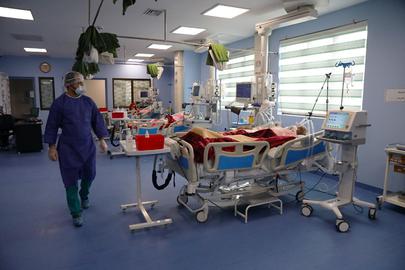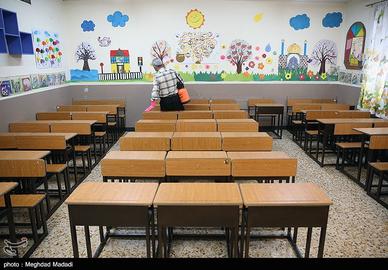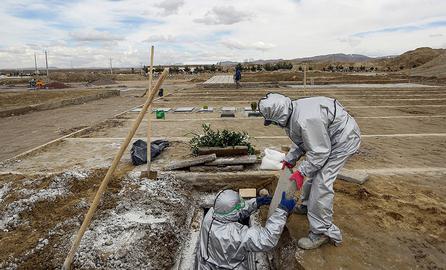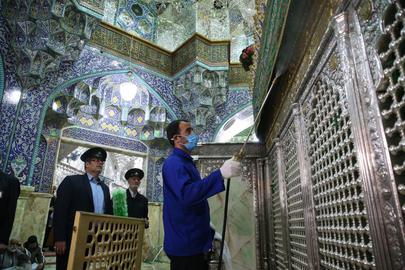“Iran now faces an uninterrupted epidemic,” the president of Tehran University of Medical Sciences, Dr. Abbas Ali Karimi, announced on September 28. The country continues to reel from its third devastating wave of coronavirus, and the new terminology coincided with a row between the health ministry and the central bank about medical staff not being paid and about what happened to the billion euros allocated to fight the crisis. It has become quite clear that a majority of Iranian health workers have not been paid for several months. But why? Where are the funds?
It has been more than seven months since the coronavirus outbreak started in Iran. The “uninterrupted epidemic” is the outcome of a chain of events: officials withholding information and refusing to acknowledge the outbreak when it first began, rallies to celebrate the anniversary of the Islamic Revolution on February 11, parliamentary elections on February 21, religious ceremonies and processions during the holy months of Ramadan and Muharram, nationwide university entrance exams and the reopening of schools and universities. In the meantime, people have been given no choice but to travel to and from work to make a living.
While infections and fatalities rise, the clash between the health ministry and Iran’s Central Bank over the National Development Fund’s allocations to fight the pandemic continues. According to published reports, as of September 28, the health ministry has received only 27 percent of the total promised amount. Where is the remaining 73 percent of the one billion euros that had been allocated to the health sector?
A few days ago, in a letter to the public released online, Health Minister Saeed Namazi complained about the delay and said he felt ashamed before health workers because he had no budget to pay their unpaid wages throughout such difficult days.
After this address went online, Abdolnaser Hemmati, governor of the central bank, offered part of the agreed amount to the health ministry, but Saeed Namaki refused to accept it. “I was afraid that [receiving] this would create problems for the money supply and the economy,” he said on September 27. “So I ordered to return it. From now on we shall keep our mouths shut. My colleagues will work even if they do not get paid. We are here to sacrifice our lives.”
Prior to this, the governor of the central bank tried to justify the delay in the payment to the health ministry. “To control its balance sheet and to keep inflation down, the central bank has to resist certain requests even if they are justified,” he said. “Avoiding the conversion of the National Development Fund’s foreign currency to rial is part of this policy.”
But Hossein Ali Shahriari, chairman of the parliament’s Health Committee, challenged this explanation. “A billion dollars has been withdrawn from the fund but has been spent somewhere else,” he said. “The government must come clean and respond to the just demands of health workers. For close to 10 months employees and workers in this sector have not been paid and, what is more, the pressure of coronavirus has exhausted medical staff.”
His words are exactly what a group of nurses at Rouhani Hospital in the northern city of Babol wanted to hear. As videos posted on social media on September 28 show, the nurses held a rally on the hospital campus demanding an explanation as to why they had not been paid for their work, including overtime.
As the situation across the country became more critical, education minister Mohsen Haji Mirzaei announced that the authority to close schools has now been passed to the interior and the health ministries. From now on, he said, his ministry is only responsible for providing students with different options for studying. He promised that problems with the education ministry’s SHAD remote learning app would be solved within a week.
High government officials continue to insist that the reopening of schools has not contributed to the recent surge in infections, and yet every day there are new reports of students and teachers being infected with Covid-19. On September 28, Hossein Argiv, governor of Fasa in Fars province, reported that 16 students and two teachers in the city had been infected. He said that affected schools have been closed down and “if, in any other school, the students show the tiniest symptoms of the disease, they will be quarantined for two weeks.”
Provinces Round-up
Figures reported from provinces show that the situation is even more critical than what official statistics had previously led the public to believe. Hospitals caring for Covid-19 patients in Urmia, the capital of West Azerbaijan, in Isfahan and in the city of Behbahan in Khuzestan report that they have been filled to capacity. During the third week of September, Anooshirvan Mohseni Bandpey, the governor of Tehran province, had reported the same thing about hospitals in his province.
The crisis in Qazvin will lead to the province being locked down, according to Manouchehr Habibi, deputy governor of the province. On September 27 he proposed the closing down of universities, schools, seminaries, vocational schools, gyms, theaters, reception halls, restaurants, coffee shops and hairdressing salons for between one and two weeks. However, such measures for lockdown must be approved by interior and health ministries. In the last 24 hours a record number of 70 coronavirus patients were hospitalized in Qazvin and 12 Covid-19 patients died.
Also, in the last 24 hours in Alborz province, 10 Covid-19 patients died, bringing the total death toll for the province to 1,164, reported Mohammad Fathi, president of Alborz University of Medical Sciences. In the same time period, 93 new patients were hospitalized.
In her daily briefing for September 28, health ministry spokeswoman Dr. Sima Sadat Lari announced the official coronavirus statistics for the last 24 hours.
Dr. Lari also reported that out of the 31 Iranian provinces, currently 30 provinces are in a high state of alert.
This is part of IranWire's coronavirus chronology. Read the full chronology.
visit the accountability section
In this section of Iran Wire, you can contact the officials and launch your campaign for various problems




























comments